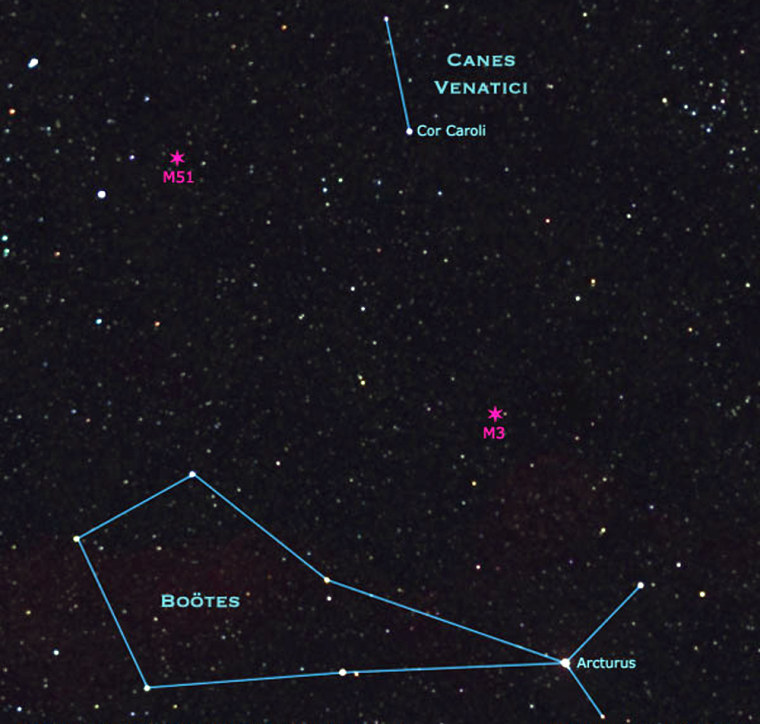Soaring high in the eastern sky and almost overhead at around midnight are the two stars marking the Hunting Dogs, known as Canes Venatici.
Located about a third of the way from the end of the Big Dipper's handle and below it, these dogs were placed in the sky to assist Boötes, the Bear Driver, in his daily task of pursuing the Big Bear (Ursa Major) around the pole of the heavens. Unlike the two faithful canine companions of Orion, the Hunter (Canis Major and Canis Minor), which are separate constellations in of themselves, the two Hunting Dogs of Boötes are both considered a single constellation (hence the plural "Canes" as opposed to the singular "Canis").
Of the two stars that mark the Hunting Dogs, the brightest is Cor Caroli, known as the "the Heart of Charles." A popular story is that the star was so-named by Edmund Halley in honor of King Charles II of England. However, upon delving deeper into this star's history, it is found that this star's original name was "Cor Caroli Regis Martyris" honoring the executed Charles I. Cor Caroli marks the position of "Chara," one of the two hunting dogs in the mythological outline of the constellation. The other dog is named "Asterion" and is marked by the other, fainter star.
What to look for
Two objects in Canes Venatici are worth looking for. The first is a beautiful and bright globular cluster, first seen by Charles Messier in 1764 and was listed as number three in his famous catalogue of deep-sky objects.
In a good pair of binoculars, M3 looks like a fuzzy star. But with a small telescope it appears as a circular, nebulous object. Larger instruments will bring out the cluster's full glory: a beautiful ball of tiny countless star images, with streams of stars seemingly running out from all sides. Perhaps 40,000 light years away, M3's diameter is estimated to be 220 light years.

The other object, also discovered by Messier in October 1773, is M51. It is not a cluster of stars, but one of the nearest and brightest galaxies relative to our own. This was also the very first galaxy to show a spiral form and hence has come to be known as the "Whirlpool Galaxy."
A good pair of binoculars will show it as a faint patch of light. Unfortunately, you'll need a telescope of at least eight-inch aperture if you hope to get a glimpse of this galaxy's spiral arms.
Many years ago, under a very dark and clear sky at Long Island's Custer Institute (http://www.custerobservatory.org/), I was readily able to discern the spiral coils of M51 using a 10.1-inch Dobsonian reflector. There is also a much smaller satellite galaxy — NGC 5195 — that appears just off the end of one of the spiral arms of M51.
Slideshow 12 photos
Month in Space: January 2014
When you are gazing at this entire star system, keep in mind that you are looking out into space to a distance of some 35 million light-years.
The great diamond of spring
Cor Caroli is the faintest of four stars that comprise a large diamond frame that can be found high in the sky and due south at around midnight local daylight time.
The other stars in the diamond are Denebola (marking the tail of Leo, the Lion), Arcturus (in Boötes) and Spica (the spike of wheat in the hand of Virgo). Some guidebooks call it the "Virgin's Diamond," though others refer to it simply as "The Great Diamond."
Unlike the famous Summer Triangle, the Diamond is nowhere near the Milky Way, but it overlaps a great number of other milky ways. For just east of Denebola is a region of the sky known as the "Realm of the Galaxies," where there's a concentration of thousands of galaxies located between 40 and 70 million light years from us. So it is possible that as you run across these pale little patches of light in your telescope, irregularly shaped, round or elongated in appearance, that you are gazing upon galaxies whose light may have started toward the Earth around the time of the extinction of the dinosaurs.

